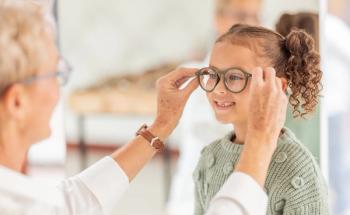
Ensuring patient success with contact lenses
Contact lenses are a large part of any general eye care practice. It is one source of great pride and satisfaction when a patient new to contact lenses first sees clearly without his spectacles, and we all enjoy seeing that epiphany. Yet, like with all experiences, the new soon wears off, and those patients who started out with the best of intentions regarding their contact lens wear and care can slip into some not-so-healthy habits.
Contact lenses are a large part of any general eye care practice. It is one source of great pride and satisfaction when a patient new to contact lenses first sees clearly without his spectacles, and we all enjoy seeing that epiphany. Yet, like with all experiences, the new soon wears off, and those patients who started out with the best of intentions regarding their contact lens wear and care can slip into some not-so-healthy habits. Overall rates of non-compliance with contact lens wear and care are routinely cited as ranging from 40%-91%.1,2
During the course of a busy clinic day, patients presenting for contact lens follow-up are often given the perfunctory vision check and slit lamp evaluation and sent on their merry way. This means some of those
"An ounce of prevention is worth a pound of cure,” so the old saying goes, and the best way to prevent a contact lens adverse event is by strict adherence to established wear and care regimens. The best way to have patients comply is through continual reinforcement of good habits, and the best time to
The contact lens technician can play a pivotal role in this regard, as more often than not, the tech spends far more time with the patient than the doctor-time that can be pivotal in evaluating your contact lens wearers and heading off any potential problems.
Opening questions
Before the doctor ever sees the patient, some perfunctory questions will help assess the patient’s attitude about her contact lens experience.: Some considerations:
• Does the patient smoke? If she does, advise her to stop. Studies have shown that contact lens wearers who smoke have more problems than those who don’t.3
• Look at the patient’s fingernails; short and smooth fingernails help avoid damaging contact lenses or scratching the eye on lens application and removal.
• Does the patient have any spectacles? This can become important if the patient develops some ocular irritation or redness with contact lens wear but continues to wear the contact lenses and worsen the condition all because she had no other method of vision correction. Spectacles allow the eyes to have a break from contact lens wear.
Lens types and wear schedules
The next question is what type of contact lens is the patient wearing? Even though you may have that information in front of you in the chart, it is important for the patient to know what type of contact lens she has in her eye. I am always amazed at the number of patients who have no clue about what contact lens they are wearing, and I am not alone; a study conducted at the Centre for Contact Lens Research (CCLR) found that only half of the study participants were able to recall the brand names of their habitual contact lenses from memory.4
Also inquire about the patient’s wearing schedule. Is he wearing his lenses daily wear only? If so, how many hours per day are the lenses in the eye? Is he wearing the lenses for extended wear? If so, how many days continuously is he wearing the lenses? It is also confounding to find that patients often wear a lens designed for strict daily wear for extended overnight periods. A recent study reported that 6% of contact lens patients wear their lenses overnight, despite being advised to wear them for daily wear only.5 Many times the patient will be hesitant to admit to overnight wear, yet if the question is asked in a non-confrontational way, the patient will often confess to extending his contact lens wearing schedule. I often remind patients who are sleeping in their lenses that this practice is associated with a 10-fold increased risk of microbial keratitis over contact lenses worn as strictly daily wear.6
Lens replacement
Likewise, patients should be asked about their replacement regimen. Many patients will
There are as many excuses for the practice as there are contact lenses on the market. Some feign forgetfulness, some ignorance, and some will tell you they see no reason “to throw away a perfectly good contact lens.” I often liken this to the “last razor” analogy. I am pretty good about replacing my disposable razors regularly, but that last one in the package seems to last about twice as long as the others.
Replacing contact lenses at recommended intervals allows for better comfort. A study conducted by the Centre for Contact Lens Research shows that silicone hydrogel lens patients who are compliant with the manufacturer-recommended replacement schedule have better comfort and vision at the end of the day than non-compliant patients.8
Using lenses beyond their recommended replacement schedules has been associated with a 4-fold increased risk in infections compared with lenses replaced at appropriate intervals (see Figures 1 and 2).9 It doesn’t hurt to remind your patients that contact lenses are medical devices and are regulated by the U.S. Food and Drug Administration-they aren’t buying shoes here.
Smartphone-based applications and electronic reminder services are a great way to help tech-savvy patients remember when to replace their lenses.
In addition to wearing times and replacement schedules, inquire about other high-risk habits. Does the patient shower in her lenses? Wear them swimming or in a hot tub? I don’t ever recommend patients swim in their contact lenses or wear them when showering or in a hot tub. Many patients are surprised at that recommendation. Knowing that many will not comply with that recommendation, I suggest they use protective goggles and, immediately after swimming, remove and clean their contact lenses before wearing them again.
Lens care
Regardless of the type of lens worn and the wearing schedule, proper lens care is essential to maintaining good ocular health. The patient should be asked about her lens care regimen. I find this to be a huge area of non-compliance. While many patients can’t tell you what brand of lens they are wearing, fewer still can tell you the brand of contact lens cleaning and storage solution they use. A visual aid may be helpful.
Our office keeps a display of various contact lens solutions-if the patient has no idea about her care system, she will be asked if one in our display is the brand she is using. In many cases, it is not the brand recommended at the time the lenses are dispensed.
Patients may start out with good intentions and follow the doctor’s recommendations at the onset but quickly switch to an off-brand or generic due to cost considerations. Again, it is helpful for ancillary staff to gently remind the patient that the doctor has recommended
The doctor’s recommendation is important. Studies have shown that patients are more likely to comply if the doctor has made a strong recommendation-not only about solutions but wearing times and replacement schedules.10 Does the patient wash his hands before handling contact lenses? It sounds like a no-brainer, but, again, take nothing for granted. Between 11%-49% of patients always fail to wash their hands before handling their lenses;11 and there is a 1.5 times increased risk for developing microbial keratitis and 2-times greater risk for developing sterile keratitis in patients who fail to wash their hands.3,6 Recommend the patient use a non-cosmetic soap because soaps with oils or lotions in them can transfer to the contact lens and cause irritation on lens application along with blurred vision.
Is the patient using the solution properly? Does the patient rub and rinse his contact lenses daily with the recommended solution (not water or-God forbid-saliva)? Tap water should never come into contact with soft contact lenses, and saliva contains numerous microbes that can lead to an ocular infection. If I had a nickel for every time I’ve heard a patient say, “But the bottle says, ‘no rub,’” I’d be a rich man. My standard answer: “no rub” doesn’t mean no rub.
Fortunately, most multi-purpose solutions no longer advertise “no rub.” Have the patient demonstrate how he cares for his lenses. Ask the patient to clean each lens by rubbing it gently with his index finger in the palm of his other hand, then rinsing the contact lens before placing it in the storage case. This “rub and rinse” cleaning method is sufficient with most multi-purpose solutions in use, yet not all patients perform the practice. Some 40%-75% of contact lens wearers fail to rub and rinse with their multi-purpose solutions.12
Do not allow the tip of the solution bottle to come into contact with any surface, and instruct the patient to keep the solution bottle tightly closed when not in use. Likewise, patients need to understand that sterile saline is not a disinfectant, nor are contact lens rewetting drops.
Speaking of solution, is the patient dumping the solution out daily and using fresh solution or simply “topping off’ the solution in the case? A reported 22% of wearers top off their lens case occasionally, frequently, or almost every night.4 In an attempt to save money, this practice is one shown to contribute to ocular infections.13
Old solution should never be re-used. Also, transferring solution from one container to a smaller-travel size container should be discouraged. This is another compliance concern that is often neglected in lens care while traveling, and it has been identified as a risk factor for infection among contact lens wearers.
Restrictions on liquids in carry-on luggage when flying mean that re-usable lens wearers may be tempted to transfer solutions into smaller containers. This can affect the sterility of the solution.
Use the smaller size bottles of solution when travelling. If hygiene is difficult to ensure, consider refitting the patient into a daily disposable lens.
Be sure patients inspect their lenses before application. Patients should look for nicks along the lens edge, torn lenses, or visible breaks. Damaged lenses can damage the eye, so advise patients to discard the lens and use a fresh one.
Lens case
Of all the components of contact lenses, lens cases represent the most common source of contamination and have been shown to include a host of pathogenic microorganisms, including bacteria, amoeba, and fungi.14 So, we need to ask our patients about their lens storage case. Do they ever clean it? Some 61%-79% of contact lens wearers fail to clean their case daily (see Figure 3).15 The storage case should be rinsed out daily with storage solution-never water-then wiped with a clean tissue and allowed to air dry.
Because Acanthamoeba cysts may be present in tap water and can survive for years after drying,16 I recommend using only contact lens disinfecting or multi-purpose solution for this step. Recent studies suggest that wiping your case with a clean tissue and/or placing it upside-down on another clean tissue may be additional good steps in keeping bacteria biofilms off the case.15,17
Does the patient regularly replace her storage case? Storage cases should be replaced every 1-3 months or if the case is damaged or cracked. One surefire way to see how well the patient manages her contact lenses is to ask the patient bring in her contact lenses, solutions, and storage case when she comes in to the office for her appointment. Much like your medical doctor wants you to bring in your medications at your physical exam, asking the patient bring in her contact lens paraphernalia can show how diligent she is in caring for her lenses.
Wear and care handouts
There is no statistically significant difference between patients receiving both verbal and written instructions and those receiving only oral instructions.18 But it is best to give the patient a double dose of positive reinforcement, not only with the spoken word, but with a nice handout outlining the patient’s lens type, the recommend lens wearing schedule, and the recommended solution type. Keep a copy of these recommendations in the patient’s chart, that way patients can’t say they haven’t been warned.
Failure to follow recommendations and poor hygiene can increase the risk of ocular infections such as microbial keratitis. Examples of handouts are available online from the American Optometric Association or the Association of Contact Lens Educators.
If a patient is noncompliant, often this reinforcement of his wear and care will return him to healthy habits. For those who it doesn’t, perhaps it is time to change their lens type to a daily disposable. In terms of reducing the risk of infection, single-use daily disposable lenses are the safest type of soft contact lens.
What to do when the eye is red
My staff and I tell patients to remember the “3 goods” when wearing their contacts. With the lenses on their eyes:
1. The contact ought to feel good
2. The patient ought to see good
3. The eyes ought to look good, i.e., there should be no redness.
The next point for the patient to remember is if one of these “3 goods” isn’t good, she should immediately remove the contact lens and call her eyecare practitioner. This may seem like a no-brainer, but there is an astounding number of patients who present with an adverse event that started out as a minor redness or irritation, but progressed to something far more serious because the patient continued to wear the contact lens (see Figure 4), often because he had no spectacle back up.
The contact lens acute red eye (CLARE), which can result from lens wear, has a variety of causes, including an improper fit, lens deposits, damaged lenses, corneal hypoxia, an allergic reaction to lens care solution ingredients, ocular allergy, dry eye, and, in the worst case scenario, infectious keratitis. Eye infections, while infrequent, can be devastating, preventing patients from wearing their contact lenses for extended periods and can result in permanent corneal scarring and vision loss.
Safe and successful lens wear
Contact lenses are among the safest forms of vision correction when patients follow the proper wear and care instructions. Fortunately, even with
• Haven’t understood what they’ve been told
• Choose to ignore what they’ve been told, thinking nothing bad is going to happen to them
• Forgot what they’ve been told
Compliance, however, is the key to long-term successful lens wear. Our patients’ single best way to avoid eye infections and protect their eyes is to follow recommended lens wear and care guidelines. In particular, performing a "rub and rinse" step in the lens cleaning process, reducing contact with water while wearing contact lenses, and replacing the lens case frequently. Recommendations have to be ongoing and continual at each and every visit because patients forget. One study reported that while 88% of patients were given lens care information, 23% were unable to later recollect seeing any information regarding the risks and complications associated with lens wear.19 To maximize compliance, both verbal and written information should be given and key aspects reinforced during follow-up visits to prevent any misunderstanding.20
The patient who choses to ignore a recommendation will likely show up with what I affectionately call the “positive washcloth test,” a compress over her eye to lessen the pain and photophobia from her contact lens-related infectious corneal ulcer. I am not above telling these patients that this severe complication from their contact lens abuse is going to keep them out of contact lenses for a prolonged period of time; cost them a tremendous amount of money in office visits, medications, and lost wages; and it all may have been prevented if they had only adhered to the recommended wear and care schedule.
I have noticed this discussion regarding the costs of abuse seems to hit home, or perhaps, it’s just that the patient doesn’t want to go through that pain again. While the focus of the contact lens follow-up visit is to ensure good vision and ocular health with contact lens wear, our job as eyecare professionals is to constantly reinforce good lens wearing habits and lens care so our patients can enjoy a lifetime of safe, successful contact lens wear.
References
1. de Oliveira PR, Temporini-Nastari ER, Ruiz Alves M, et al. Self-evaluation of contact lens wearing and care by college students and health care workers. Eye Contact Lens. 2003 Jul;29(3):164–7.
2. Donshik PC, Ehlers WH, Anderson LD, et al. Strategies to better engage, educate, and empower patient compliance and safe lens wear: compliance: what we know, what we do not know, and what we need to know. Eye Contact Lens. 2007 Nov;33(6 Pt 2):430–3.
3. Radford CF, Minassian D, Dart JK, et al. Risk factors for nonulcerative contact lens complications in an ophthalmic accident and emergency department: a case-control study. Ophthalmology. 2009 Mar;116(3):385-92.
4. Dumbleton KA, Woods CA, Jones LW, et al. The relationship between compliance with lens replacement and contact lens-related problems in silicone hydrogel wearers. Cont Lens Anterior Eye. 2011 Oct;34(5):216-22.
5. Jansen ME, Chalmers R, Mitchell GL, et al. Characterization of patients who report compliant and non-compliant overnight wear of soft contact lenses. Contact Lens Anterior Eye. 2011 Oct;34(5):229-35.
6. Dart JK, Radford CF, Minassian D, et al. Risk factors for microbial keratitis with contemporary contact lenses: a case-control study. Ophthalmology. 2008 Oct;115(10):1647-54.
7. Dumbleton K, Woods C, Jones L, et al. Patient and practitioner compliance with silicone hydrogel and daily disposable lens replacement in the United States. Eye Contact Lens. 2009 Jul;35(4):164-71.
8. Dumbleton K, Woods C, et al. Role of compliance with the replacement frequency of silicone hydrogel lenses on subjective comfort and vision. Optom Vis Sci. 2009;86:90626.
9. Saw SM, Ooi PL, Tan DT, et al. Risk factors for contact lens-related fusarium keratitis: a case-control study in Singapore. Arch Ophthalmol. 2007 May;125(5):611-7.
10. Homedes N. Do we know how to influence patients' behaviour? Tips to improve patients' adherence. Fam Pract .1991 Dec;8(4):412-23.
11. Sokol JL, Mier MG, Bloom S, et al. A study of patient compliance in a contact lens-wearing population. CLAO J. 1990 Jul-Sep;16(3):209-13.
12. Hickson-Curran S, Chalmers RL, Riley C. Patient attitudes and behavior regarding hygiene and replacement of soft contact lenses and storage cases. Cont Lens Anterior Eye. 2011 Oct;34(5):207-15.
13. Stapleton F, Dart JK, Minassian D. Risk factors with contact lens related suppurative keratitis. CLAO J. 1993 Oct;19(4):204-10.
14. Hall BJ, Jones L. Contact lens cases: The missing link in contact lens safety? Eye Contact Lens. 2010 Mar;36(2):101-5.
15. Wu Y, Carnt N, Stapleton F. Contact lens user profile, attitudes and level of compliance to lens care. Cont Lens Anterior Eye. 2010 Aug;33(4):183-8.
16. Sriram R, Shoff M, Booton G, et al. Survival of Acanthamoeba cysts after desiccation for more than 20 years. J Clin Microbiol. 2008 Dec;46(12):4045-8.
17. Wu YT, Zhu H, Willcox M, et al. The effectiveness of various cleaning regimens and current guidelines in contact lens case biofilm removal. Invest Ophthalmol Vis Sci. 2011 Jul 15;52(8):5287-92.
18. Cardona G, Llovet I. Compliance amongst contact lens wearers: comprehension skills and reinforcement with written instructions. Cont Lens Anterior Eye. 2004 Jun;27(2):75-81.
19. Morgan PB. The Science of Compliance: a guide for the eye care professional. 2007.
20. Efron N. The truth about compliance. Cont Lens Anterior Eye. 1997;20(3):79-86.
Newsletter
Want more insights like this? Subscribe to Optometry Times and get clinical pearls and practice tips delivered straight to your inbox.



















































.png)


